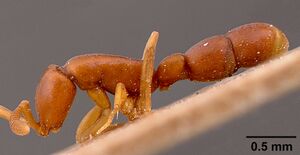Probolomyrmex filiformis
| Probolomyrmex filiformis | |
|---|---|

| |
| Scientific classification | |
| Kingdom: | Animalia |
| Phylum: | Arthropoda |
| Class: | Insecta |
| Order: | Hymenoptera |
| Family: | Formicidae |
| Subfamily: | Proceratiinae |
| Tribe: | Probolomyrmecini |
| Genus: | Probolomyrmex |
| Species: | P. filiformis |
| Binomial name | |
| Probolomyrmex filiformis Mayr, 1901 | |
Identification
Distribution
Latitudinal Distribution Pattern
Latitudinal Range: -33.96667° to -33.96667°.
| North Temperate |
North Subtropical |
Tropical | South Subtropical |
South Temperate |
- Source: AntMaps
Distribution based on Regional Taxon Lists
Afrotropical Region: South Africa (type locality).
Distribution based on AntMaps
Distribution based on AntWeb specimens
Check data from AntWeb
Countries Occupied
| Number of countries occupied by this species based on AntWiki Regional Taxon Lists. In general, fewer countries occupied indicates a narrower range, while more countries indicates a more widespread species. |

|
Estimated Abundance
| Relative abundance based on number of AntMaps records per species (this species within the purple bar). Fewer records (to the left) indicates a less abundant/encountered species while more records (to the right) indicates more abundant/encountered species. |

|
Biology
Castes
Images from AntWeb
   
| |
| Paratype of Probolomyrmex guineensis. Worker. Specimen code casent0102218. Photographer April Nobile, uploaded by California Academy of Sciences. | Owned by NHMUK, London, UK. |
    
| |
| Worker (major/soldier). Specimen code sam-hym-c002224. Photographer Hamish Robertson, uploaded by California Academy of Sciences. | Owned by SAMC, Cape Town, South Africa. |
Nomenclature
The following information is derived from Barry Bolton's Online Catalogue of the Ants of the World.
- filiformis. Probolomyrmex filiformis Mayr, 1901b: 3 (w.) SOUTH AFRICA.
- Type-material: lectotype worker (by designation of Taylor, 1965: 353), 1 paralectotype worker (missing head and gaster).
- Type-locality: lectotype South Africa: Cape Colony, Port Elizabeth (H. Brauns); paralectotype with same data.
- Type-depository: NHMW.
- Status as species: Emery, 1911d: 52; Santschi, 1914d: 312; Arnold, 1915: 34; Wheeler, W.M. 1922a: 762; Taylor, 1965d: 353 (redescription); Brown, 1975: 11; Bolton, 1995b: 366.
- Distribution: South Africa.
Unless otherwise noted the text for the remainder of this section is reported from the publication that includes the original description.
Description
Worker
Taylor (1965) - The aforementioned specimens (see the type material section below) have the following dimensions (lectotype cited first); HL, 0.76 mm.; HW, 0.48 mm.; SL, 0.54 mm.; CI, 63; SI, 113; WL, 1.03, 1.01 mm.; PW, 0.35, 0.37 mm.; dorsal petiole width, 0.23, 0.24 mm. ; petiolar node index, 66, 65; petiole height, 0.39, 0.39 mm.; petiolar node length, 0.34, 0.35 mm.; lateral petiolar index, 87, 90. The descriptions of Mayr and Arnold adequately cover the general features of P. filiformis. The carina enclosing the posterior face of the node has its edge very feebly emarginate at the dorsal mid-line. When viewed from above, the declivitous face of the propodeum is moderately concave, the depth of the concavity being about one-eighth the distance between the dorsalmost corners of the posterolateral propodeal lamellae.
Details of sculpturation, required for comparison with the related Probolomyrmex guineensis, as follows: the 2 general sculptural elements, fine shagreening and associated coarse punctures, are present, but the puncturation is relatively weak. Entire surface of body, including mandibles, antennae and legs, very finely shagreened and moderately shining. Front and sides of head, entire pronotum and dorsum of mesosoma with very indistinct vestigial traces of overlying puncturation. Individual punctures increasingly distinct towards lower parts of sides of mesosoma; best developed, though still somewhat indistinct, on the mes- and metepisterna. Puncturation of sides of petiole similarly developed, that of first two gastric segments slightly less so.
Pilosity normal for the genus. Whitish, extremely fine, adpressed pubescence moderately well developed over entire body, most abundant on gaster and least so on dorsum of mesosoma and underside of head. The visible apical segments of maxillary and labial palpi, and the preapical maxillary segment, proportioned as in Probolomyrmex angusticeps.
Type Material
Taylor (1965) - This is the type species of its genus, by monotypy. I have examined two syntype workers from the Mayr collection (Naturhistorisches Museum, Vienna); one is undamaged but the other lacks the head and gaster. These individuals are here selected as lectotype and paralectotype respectively and have been labelled accordingly.
References
- Mayr, G. 1901b. Südafrikanische Formiciden, gesammelt von Dr. Hans Brauns. Ann. K-K. Naturhist. Mus. Wien 16: 1-30 (page 3, worker described)
- Mbenoun Masse, P.S., Ebolo, G.L.M., Titti, G.E., Mony, R. (2021) Ant species richness, abundance and functional groups along an elevation gradient in Central Cameroon Biodiversity Journal, 2021, 12 1.: 179–194. Biodiversity Journal 12, 179–194 (doi:10.31396/biodiv.jour.2021.12.1.179.194).
- Taylor, R. W. 1965d. A monographic revision of the rare tropicopolitan ant genus Probolomyrmex Mayr (Hymenoptera: Formicidae). Trans. R. Entomol. Soc. Lond. 117: 345-365 (page 353, see also)
References based on Global Ant Biodiversity Informatics
- Emery C. 1911. Hymenoptera. Fam. Formicidae. Subfam. Ponerinae. Genera Insectorum 118: 1-125.
- Lévieux J. 1972. Les fourmis de la savane de Lamto (Côte d'Ivoire): éléments de taxonomie. Bulletin de l'Institut Fondamental d'Afrique Noire. Série A. Sciences Naturelles 34: 611-654.
- Santschi F. 1914. Formicides de l'Afrique occidentale et australe du voyage de Mr. le Professeur F. Silvestri. Bollettino del Laboratorio di Zoologia Generale e Agraria della Reale Scuola Superiore d'Agricoltura. Portici 8: 309-385.
- Taylor R. W. 1965. A monographic revision of the rare tropicopolitan ant genus Probolomyrmex Mayr (Hymenoptera: Formicidae). Transactions of the Royal Entomological Society of London 117: 345-365.
- Wheeler W. M. 1922. Ants of the American Museum Congo expedition. A contribution to the myrmecology of Africa. VIII. A synonymic list of the ants of the Ethiopian region. Bulletin of the American Museum of Natural History 45: 711-1004

